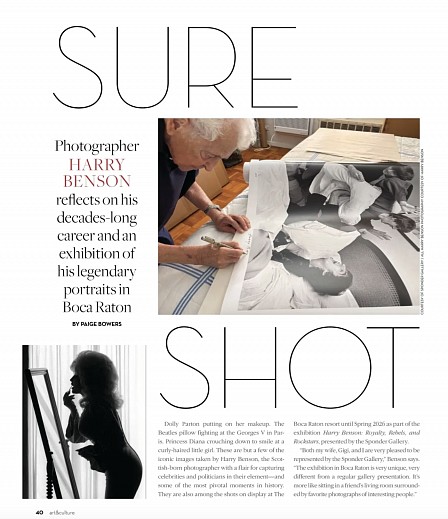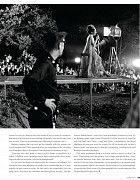





Art & Culture Magazine | Harry Benson: Sure Shot
October 1, 2025
Fall 2025 Issue
Harry Benson reflects on his decades long careed and an exhibition of his ledendary portraits in Boca Raton.
Dolly Parton putting on her makeup. The Beatles pillow fighting at Georges V in Paris. Princess Diana crouching down to smile at a curly haired little girl. These are but a few of the iconic images taken by Harry Benson, the Scottish born photographer with a flair for capturing celebrities and politicians in their element, and some of the most pivotal moments in history. They are also among the shots on display at The Boca Raton resort until spring 2026 as part of the exhibition Harry Benson: Royalty, Rebels, and Rock stars, presented by Sponder Gallery. “Both my wife, Gigi, and I are very pleased to be represented by Sponder Gallery,” Benson says. “The exhibition in Boca Raton is very unique, very different from a regular gallery presentation. It's more like sitting in a friend's living room surrounded by favorite photographs of interesting people.”
Benson has had a rollicking career on assignment for magazines that include Life, Time, Newsweek, Town & Country, Vanity Fair, Paris Match, GQ, W, Esquire, People, Vogue, and Architectural Digest. Frank Sinatra once glared at him because he was in the way when he and Mia Farrow arrived at Truman Capote's Black and White ball in 1966. The very next year Barbara Streisand berated him after he left an assigned area for photographers to get a better picture of her performing. Occasional abuse aside Benson has always gotten close and gotten the shot.
“I don't know what I would have done if I had to work for my living,” Benson says “because for 60 plus years I have gotten to do what I love.”
Born in Glasgow in 1929 Benson acknowledges that he wasn't a good student in regular school. When his father gave him a Coronet Cub box camera one year for Christmas, he found something he really loved doing. He was about 12 years old then, he says, and a big fan of James Cagney movies and Life Magazine. War photojournalism was making an impression on him, and he still remembers the front-page picture of a boy crying in front of the ruins of his house, which had just been bombed by the Germans. Sensing his son's passion for pictures, Benson's father enrolled him in the Glasgow School of Art.
After graduation, Benson's first job was as a wedding photographer. “It wasn't a bad way to learn” he recalls. “It teaches discipline. There was a certain order that had to be followed: photos of the bride and groom alone, then with their parents, then with the wedding party, followed by the guests and the first dance.”
Then, newspapers beckoned. Benson's first published photograph was of a young roe deer, and he remembers the thrill of seeing the man next to him on the bus opened the Glasgow Evening Times to his picture. He moved to London, where there were at least seven daily papers at the time, and plenty of pressure to beat the competition on news stories. Working for the Daily Express, Benson took whatever assignment came up, getting as close as he could to the action to get the best shots. He was about to go to Africa on assignment when the night editor called and told him he'd be going to Paris instead, and with The Beatles, to boot.
It was the beginning of Beatlemania, and Benson's images of the mop topped quartet came to define the mad cap excitement of that time. While in Paris the band found out that I want to hold your hand went to number one in the United States. John Lennon snuck up behind Paul McCartney and hit him with a hotel pillow. Ringo Starr and George Harrison joined in. Benson started shooting, and one of the most widely seen and beloved photos in pop culture was born.
“Everything is timing,” Benson says of his approach “you have to come in with an idea, and if you can get a person to move, it releases them as soon as you start taking a photograph. Your timing is ticking along. You only have so much time no matter who they are. People feel awkward if you don't give them encouragement or suggestion, but you need to keep them moving. I am always looking for unexpected surprises. You have to be prepared for those.”
One unexpected surprise: his wife, Gigi, who he met almost 60 years ago while covering Prince Philip at a Houston charity event. Benson had moved to New York, because it had been his dream to live in America. Gigi, then a graduate student at the University of Texas, was at the event with her parents. She says that moment Harry stepped into the elevator, she looked at her mother, “because he was really cute.”
Two years later (“but it feels like 2 weeks”) Gigi says, Gigi and Harry married. They had two daughters together, Wendy Benson Landes, an actress, and Tessa Benson Tooley, a film producer and animal rights advocate. Now Gigi helps Benson with his files, copywriting, and paperwork, which she says “is quite a lot to do” because of the sheer volume of pictures he has taken.
“She's my wife who does all the work” Benson says playfully.
Not that Benson has much idle time. He has photographed royalty, politicians, cultural icons, and major historical moments. He chronicled the civil rights movement of the 1960s, the fall of the Berlin Wall, and the aftermath of Hurricane Katrina. He was there when Bobby Kennedy was shot, capturing the ensuing chaos. “He was looking at me and he was dying” Benson recalls “the Kennedy people asked me how I could do this. But I did this, and I had done it before. I was getting punched in the side of the head, but I wasn't going to walk away from a hellish situation. I've been in other situations where people tried to get my film off me. And I told myself I didn't go 2,000 miles to get my film taken off me.”
He was also there when President Richard Nixon resigned, documenting his disgrace and his wife's tears. “Nixon was inherently shy, but he was always considerate and would make room in the plane for me on important presidential trips, including the ones to Russia, Egypt, and Israel” Benson says “Mrs. Nixon was very kind, and the staff loved her. She never forgot her birthday or to ask someone who had been ill how they were feeling.”
In 1976 Benson went to Dolly Parton's home in Nashville the photograph her. She was finishing her makeup when Benson realized he had his shot. He told Dolly to keep doing what she was doing, and though the lights weren't set up yet, Benson says the image of her in front of a window, leaning toward the mirror and putting on lipstick, was his favorite from that session. There's no mistaking her silhouette for anyone else’s.
Benson cautions that you can't get too friendly with the people you cover, because they'll start ignoring what you want them to do, or telling you what they'd like to do instead. That is a recipe for disaster he says. “Someone says they want to meet you for dinner or breakfast or a drink. You think you're getting to know them, but in reality, they're getting to know you and how you can be manipulated.”
Yet it's clear that there are subjects like the Nixons, for example, for whom he has some affection, no matter how businesslike he is or how quickly he gets down to work. He has had to be competitive over his long career, but there are countless anecdotes about people, like the actress Sharon Stone, who have been absolutely charmed by him. After Benson spoke with Queen Elizabeth the II about his love of dogs (he and Gigi have two; Daisy a pug and Tilly; a dachshund) Her Royal Highness let him play with her corgis. For all his tough talk, he has had a tender heart, one with an eye toward connecting, building trust, and finding a common humanity.
“The most important thing is to know when to move in close he says. “Don't hang back like a baby. Get in there and get the best, clearest picture because that's why you were sent. You do it because you realize if you miss the opportunity, you're going to be up against some embarrassment. Maybe the person doesn't want to be photographed, or maybe they don't want to be photographed in a certain situation. But I'm getting paid to get close.”
Back to News
